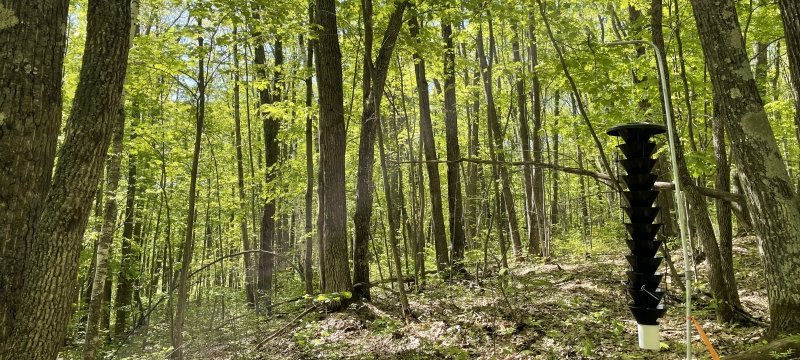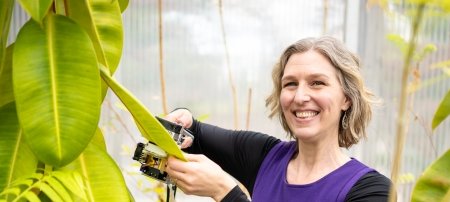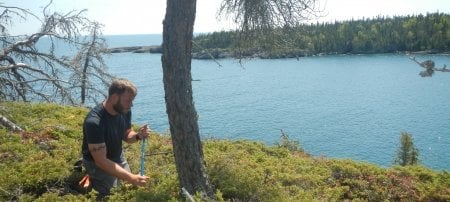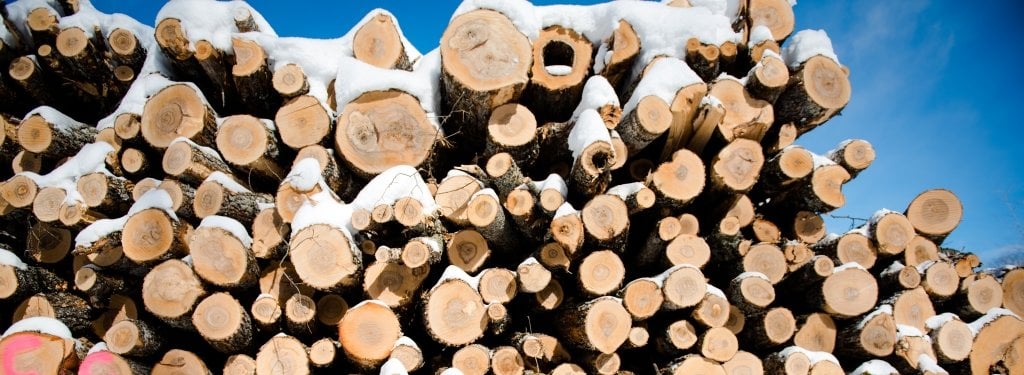A binational collaborative project is exploring environmental factors that affect the northward expansion of oak wilt, a fatal tree disease spread by sap beetles.
Researchers from Michigan Technological University and the Ontario Ministry of Natural Resources and Forestry in Canada are working to contain the spread of oak wilt. The fungal disease is currently found in 24 states and can decimate both forest and urban plantings, killing otherwise healthy trees. In addition to landscape blight, it impacts wildlife habitat and the timber industry.
The northern limit of the disease reaches the 46th parallel in Michigan, Wisconsin and Minnesota. The line hasn’t moved much since it was observed in the 1980s, but climate change is expected to impact the boundary in years to come as environmental conditions change. Project collaborators are particularly concerned about the establishment of oak wilt along the U.S.-Canada border and into Canada.
The idea for the project started when two colleagues got together for dinner. Tara Bal, assistant professor with the Michigan Tech College of Forest Resources and Environmental Science, discussed with her counterpart Sharon Reed why oak wilt, so close to the border, had not moved over the line in recent decades. Reed, the forest health research scientist for the Ontario Ministry of Natural Resources and Forestry, has studied oak wilt since 2017.
"We have oak trees and the beetle species (in Michigan’s Upper Peninsula), but the disease had not reached northern oaks in New York, Canada and elsewhere," said Bal. "In June 2023, oak wilt was confirmed for the first time in southern Ontario, Canada."
About the Researcher
The collaborators are now conducting beetle identification training and leading joint presentations, and will be working together on future research papers. They’re working to more effectively predict the risks and where and when oak wilt might be moving north, plus refine prevention guidelines that are based on beetle flight data collected in other places in the Midwest.
“This could reduce the burden on industry and become more scientifically appropriate for areas farther north,” said Bal.

How Oak Wilt Spreads and What You Can Do
Sap beetles, in the Nitidulidae family of beetle species, carry the disease fungus to the trees. The disease, first shown by leaf-browning at the top, moves slowly through the root system of the tree. New fungal spores are transmitted by the beetles from infected trees to freshly pruned or injured trees. Oak wilt can also be transmitted longer distances when people move infected firewood.
Once a tree has oak wilt, there’s no way to save it. Red oak species can die in just a few weeks. White oak varieties may survive a couple of years.
Experts say the best ways to prevent oak wilt is to not move firewood from one place to another and avoid pruning oak trees during the growing season. If you must prune, avoid doing so from mid-April to mid-July.

Binational Funding and Support
About 20 people are directly involved in the project. Funding for the work in Michigan is made possible in part through U.S. Department of Agriculture Forest Service Eastern Region Evaluation Monitoring competitive grant funding with a 1:1 match requirement. The Michigan Invasive Species Grant Program is contributing additional funds to support the work of a Michigan Tech graduate student. The remainder is in-kind funding from different organizations.
Work being performed in Canada is funded by the Canadian Food Inspection Agency and the Manitoba Ministry of Natural Resources and Northern Development.
Natural Resources Canada, the City of Ottawa, York Conservation Authority, the Manitoba Ministry of Natural Resources and Northern Development and the Michigan Department of Natural Resources are also involved in the project, which will wrap in late spring 2024.
Information from the USFS press release announcing the project was used to compile this report.
Michigan Technological University is an R1 public research university founded in 1885 in Houghton, and is home to nearly 7,500 students from more than 60 countries around the world. Consistently ranked among the best universities in the country for return on investment, Michigan's flagship technological university offers more than 185 undergraduate and graduate degree programs in science and technology, engineering, computing, forestry, business, health professions, humanities, mathematics, social sciences, and the arts. The rural campus is situated just miles from Lake Superior in Michigan's Upper Peninsula, offering year-round opportunities for outdoor adventure.







Comments